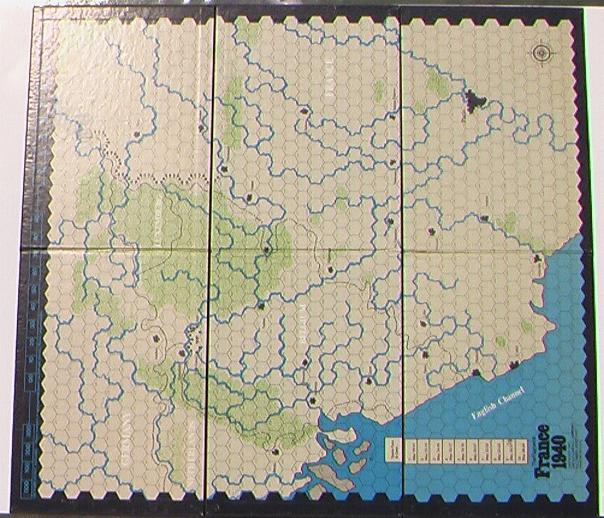The Game of France, 1940
German Blitzkrieg in the West
Avalon
Hill 1972 - #840
From the Box:
The Game of France 1940 - German Blitzkrieg in the West: May 10th, 1940. From the English Channel to the Swiss Alps were assembled nearly 300 infantry and motorized divisions, some 7,000 tanks, over 4,400 combat aircraft and over 33,000 pieces of field artillery. Over five million men were poised for what many anticipated to be a replay of World War I. The German and Allied (French, British, Belgian, and Dutch) armies were evenly matched, with a slight edge going to the Germans. But this was offset by the fact that the burden of attacking was on the Germans. It was true that they had overrun Poland in a matter of days only eight months earlier. But the Poles were heavily outnumbered by the invading German (and later, Russian) armies. It had proved nothing to the confident Allied generals. yet twenty days later the Allied armies were beaten in one of the quickest and most decisive campaigns ever fought. A third of the Allied units had simply ceased to exist. German manpower and material losses were heavy, but not a single German unit was "wiped out" as were so many of the Allied units. How did it happen?
France, 1940 is an historical game-simulation of what occurred during May 1940. It shows why, and how, the German army swept away the combined armies of France, Britain, Belgium, and Holland in just three weeks. France, 1940 recreates the military situation of May 1940. The game components and mechancis show graphically the strengths of the German army and weaknesses of the Allies. The game shows clearly why, and how, the Germans overwhelmed the Allies with a combination of slow-moving infantry, air-power, fast-moving and hard-hitting Panzer divisions, and airborne infantry units. This was the first major campaign in history in which tanks, aircraft and parachute infantry combined as the decisive factor on the battlefield. France, 1940 shows it all. A two player game, France, 1940 also allows you to explore the "What if" possibilities using different types of armies for both the Allies and Germans. These "What If...?" armies reflect such things as the Allies adopting a more "German" attitude towards airpower and/or motorized units as well as a possible French decision not to build the Maginot Line or to re-arm earlier. In all, there are fifteen "What If...?" army Orders of Battle in addition to the two (German and Allied) "Historical" ones.
Above is a reduced reproduction of the 22 by 24 inch playing board used in playing France, 1940. The playing board shows all of the essential terrain encountered during the Battle for France in May 1940. Features included are the Maginot Line, the Belgian fortresses Eben Emael and those around Liege, the Ardennes Forest and major cities. The hexagon grid is used to determine movement much like the squares on a chessboard.
Below are actual-size reproductions of some of the playing pieces used in France, 1940. These represent infantry (rectangle with an X going from corner to corner), armor (rectangle with an oval in the center), and motorized infantry (rectangle with an X going from corner to corner and an oval superimposed over it). Underneath each symbol are two numbers. The first represents the unit's movement ability. The size of the unit is shown by the "x's" above the unit type symbol (xx= a division, xxx= a corps, x = a brigade). Next to the unit type symbol is the unit's identification number (true, historical designations are used, for example the 7th German Armored or "Panzer" division was commanded by Erwin Rommel, later famous as the "Desert Fox"; the 4th French armored division, was commanded by Charles DeGaulle.) Just looking at the playing pieces in the game you can see what advantages the Germans had.
France, 1940 is similar to chess in its simplicity. After a few games the rules will become second nature to you. But, where chess is an abstraction, France, 1940 is a realistic simulation of a true historical event. Like chess, it can be as easy or as hard to play as you care to make it. Unlike chess, France 1940 is as close to reality as you're likely to get.
-
Game Box and Box Sleeve
-
One 22" by 24" Game Map
-
Die Cut Counters (Allied and German)
-
Rules of Play sheet (folds out like a map)
-
Designer's Notes and Campaign Analysis Book
-
9 Order of Battle Cards
-
Historical Situation Map pamphlet
-
Plastic Parts Tray
Game Parts:
Box Front
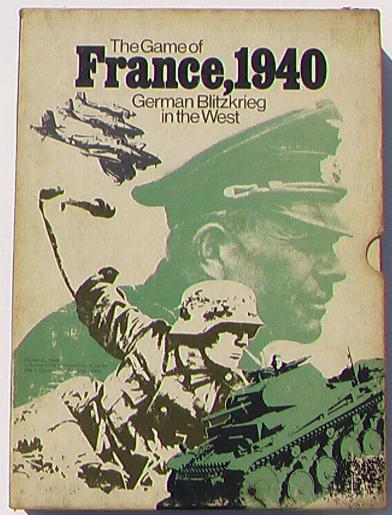
Box Back
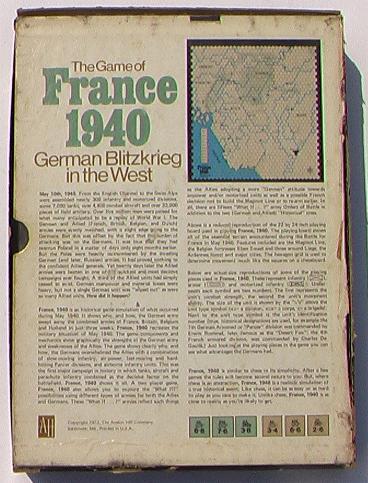
Box Sleeve and Inner Box
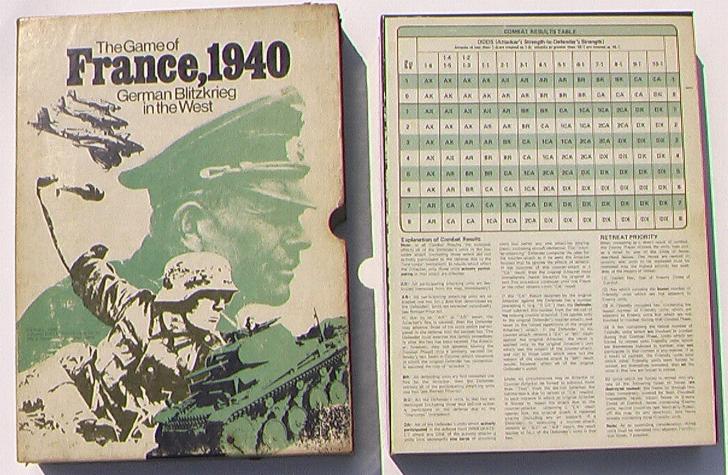
Order Form and Additional Photocopies of Rules

Designer's Notes and Parts Tray
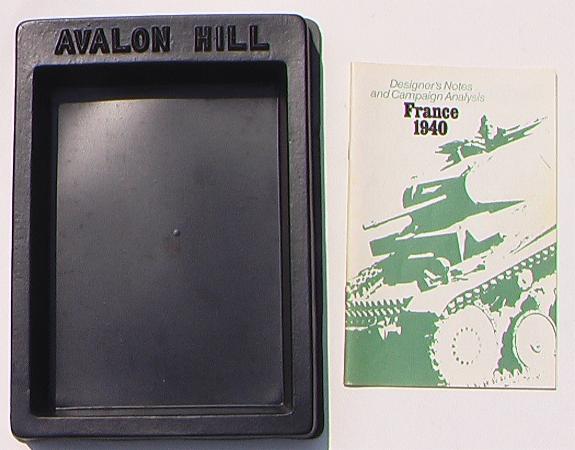
Counters
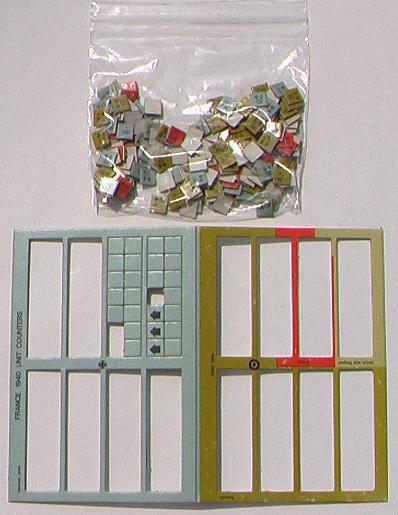
Rules and Historical Situation Map pamphlet
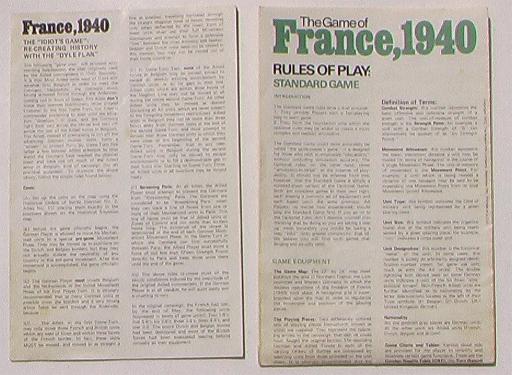
Order of Battle Cards
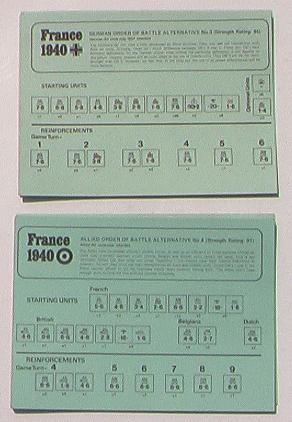
Map Board
